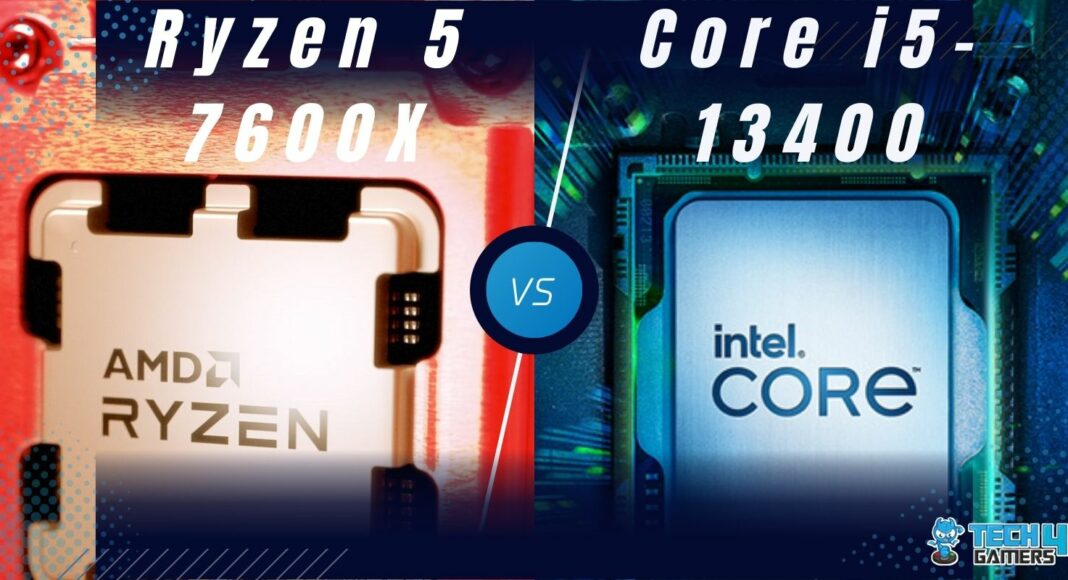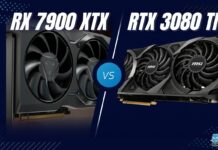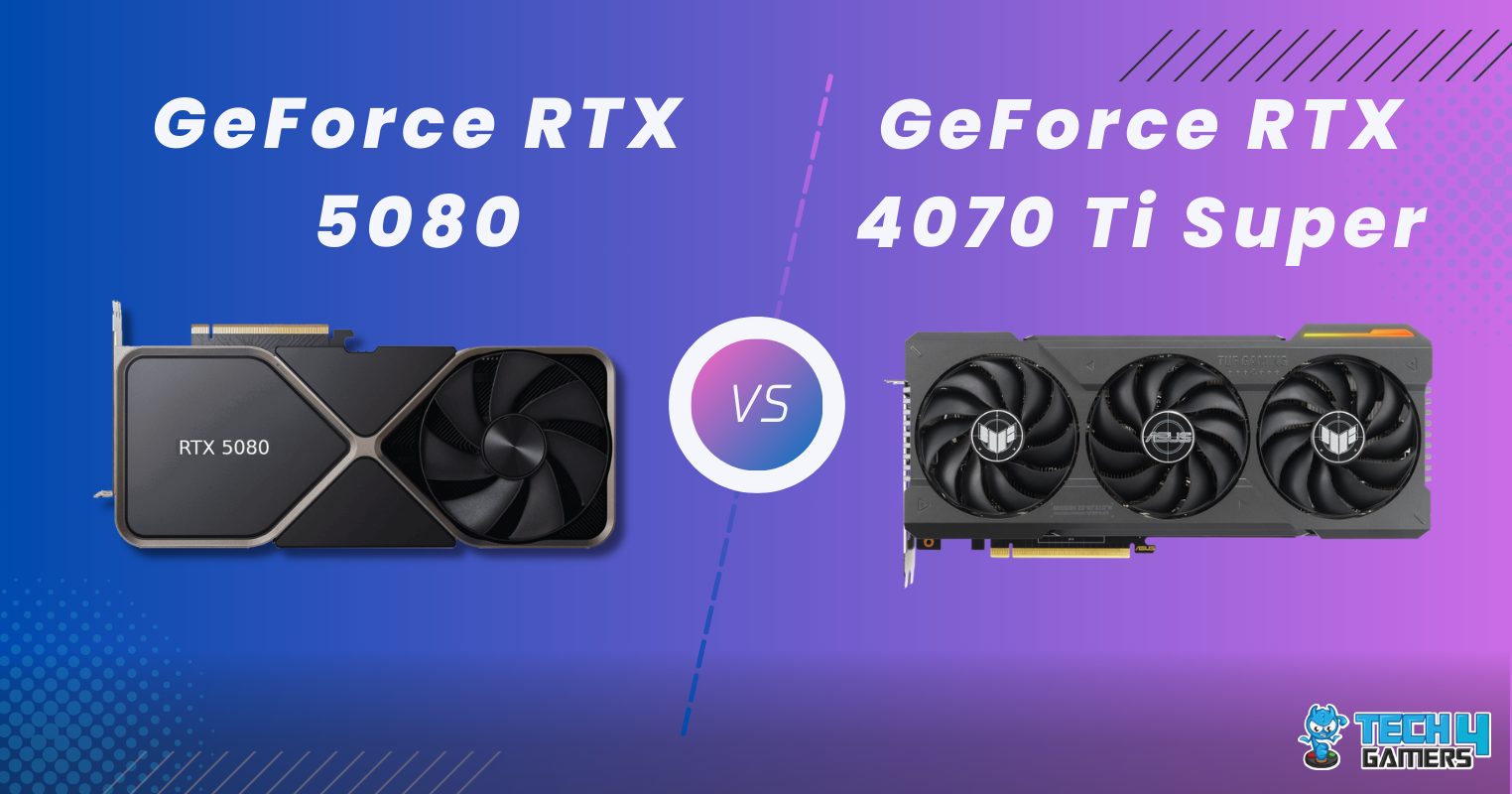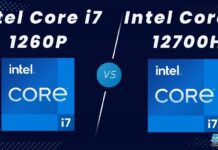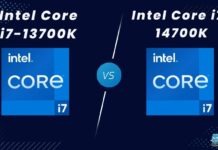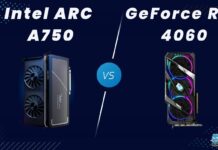AMD Ryzen 5 7600X
Rated: 8.5/10
Intel Core i5-13400
Rated: 8/10
Pros And Cons
| Graphics Card | Pros | Cons |
|---|---|---|
| Ryzen 5 7600X | ✅ Better Gaming Performance ✅ Better Specs | ❌ Higher Temperatures ❌ Higher Power Draws |
| Intel Core i5 13400 | ✅ Cheaper ✅ Runs Cooler | ❌ Lags behind in performance ❌ No extra Overclocking |
- In our Ryzen 5 7600X vs Intel i5-13400 benchmarks, the Ryzen 5 7600X was ahead of the Intel core i5-13400, performing at a 17.6% superior gaming performance than its rival.
- The temperature levels of Intel core i5-13400 ran 25.25% cooler than the AMD Ryzen 5 7600X. Moreover, the power ratings of the Ryzen 5 7600X were also much higher.
- The price of the Intel i5 13400 at the time of writing this article is around 8.7% more expensive than the price tag of the AMD Ryzen 5 7600X, indicating the Ryzen’s economical range.
- We recommend the AMD Ryzen 5 7600X as it offers peaking framerates with slightly higher power and thermal ratings. It is also available at a lower price than the Intel i5 13400.
Comparison Table
| Feature | AMD Ryzen 5 7600X | Intel Core i5-13400 |
|---|---|---|
| Architecture | Zen 4 | Raptor Lake Hybrid architecture |
| Socket | AM5 | FCLGA 1700 |
| Integrated Graphics | AMD Radeon Graphics | Intel UHD Graphics 730 |
| CPU Memory Support | DDR5 only | DDR4 and DDR5 |
| PCI Express Version | 5.0 | 5.0 and 4.0 |
| Total PCIe Lanes | 28 | 20 |
| Launch Price | $300 | $221.00 |
| Best Motherboard | Best Motherboards For Ryzen 5 7600X | - |
| Best RAM | Best RAM For Ryzen 5 7600X | - |
Ryzen 5 7600X vs Intel i5-13400 – Architectural Differences
- TDP: The AMD Ryzen 5 7600X has a TDP of 105W, while the Intel Core i5-13400 has a base power consumption of 65W and a turbo power consumption of 154W.
- Processing Nodes: The AMD Ryzen 5 7600X is built on a 5nm FinFET process at TSMC, while the i5 uses an older 10nm manufacturing process.
- Base and Boost Clocks: The AMD Ryzen 5 7600X operates at a base clock of 4.70GHz and can boost up to 5.3GHz. The Intel Core i5-13400 has a P-core base clock of 2.80GHz, an E-core base clock of 1.80GHz, and a max turbo clock of 4.60GHz for its P-cores.
- Core/Thread Count: The AMD Ryzen 5 7600X has a total of 10 cores and 12 threads. The Intel Core i5-13400 features 10 cores (4 performance and 6 efficiency) and 16 threads.
The Core i5-13400 is Intel’s recently launched i5 base variant processor, with the UHD Graphics 730 as its iGPU. In contrast, the R5 7600X is the entry-level model of AMD’s contemporary Ryzen 7000 series, featuring Radeon graphics. In Ryzen 5 7600X vs Intel i5-13400, our discussion will revolve around the specs and functional differences between the two processors.
Gaming Benchmarks
Let’s now discuss the gaming performance of the Ryzen 5 7600X vs Intel i5-13400. We will compare the performance of CPUs in 7 challenging games at 1080p resolution. These are the specifications of the test bench used.
Gaming Rig
- OS: Windows 11 Pro
- GPU: MSI GeForce RTX 3090
- MOBO 1: GIGABYTE Z690 AERO G
- MOBO 2: GIGABYTE X670E AORUS MASTER
- RAM: Corsair Vengeance DDR-5 32GB RAM 5600Mhz (2X 16GB)–CL36
- CPU Cooler: Arctic Liquid Freezer II 360mm
- PSU: ENERMAX REVOLUTION D.F. X 1050W
- Storage: Sabrent Rocket 4 Plus G 2TB
- Resolution: 1080p
Cyberpunk 2077
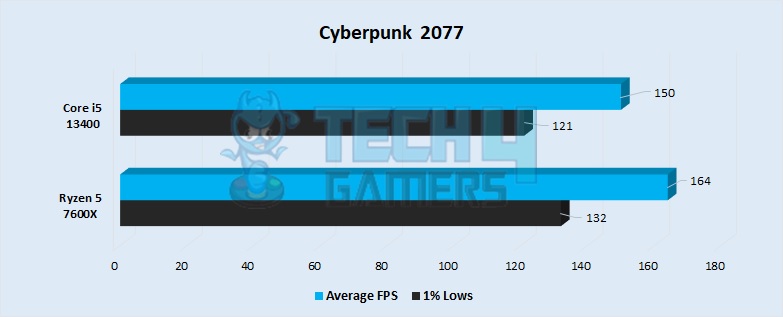
- In our testing of Cyberpunk 2077 at 1080p, we found that the Ryzen 5 7600X would average a framerate of around 164 FPS, while the i5 got around 150 FPS.
- The 1% lows were similarly different, with the i5 getting minimums of around 121 FPS, while the Ryzen 5 had a minimum framerate of around 132 FPS.
Dota 2
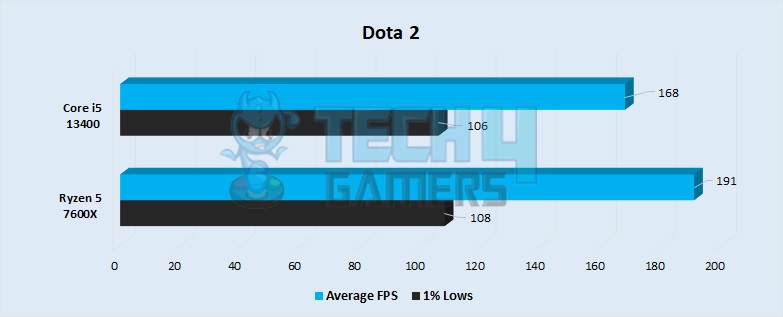
- As per our observation, the average framerate on the Ryzen 5 in Dota 2 was around 191 FPS, significantly higher than the 168 FPS average that the i5 had.
- The 1% lows were around the same number in our test, with the i5 going down to around 106 FPS, while the Ryzen 5 had lows of around 108 FPS.
Horizon Zero Dawn
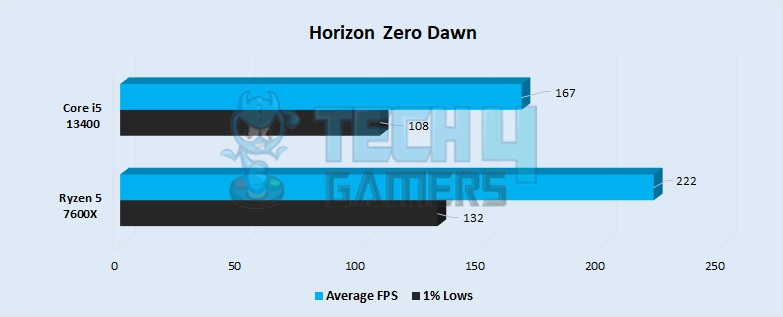
- From what we observed, the Horizon Zero Dawn showed the difference between these processors in the most drastic sense, with the i5 averaging a framerate of around 167 FPS, while the Ryzen 5 hovered around an average of 222 FPS.
- The 1% lows, though better on the Ryzen, did not carry the same absurd difference. The i5 had minimums of around 108 FPS, while the Ryzen 5 had minimums of around 132 FPS.
League Of Legends
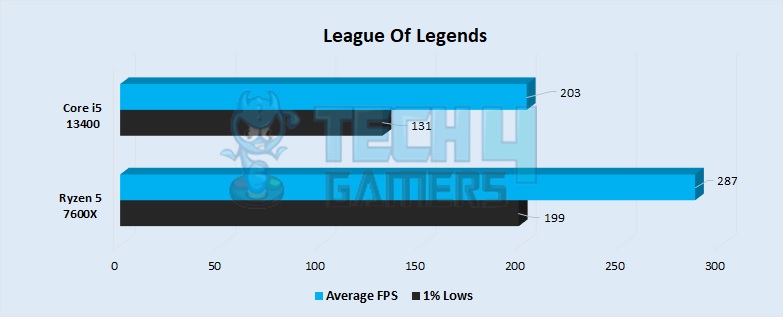
- From what we saw, the average framerates had a drastic difference in League Of Legends on both processors too, with the Ryzen 5 spitting out around 287 FPS on average, while the i5 had an output of around 203 FPS.
- The 1% lows were better on the Ryzen in our test of this game, with minimums of around 199 FPS, while the i5 got down to around 131 FPS.
Lost Ark
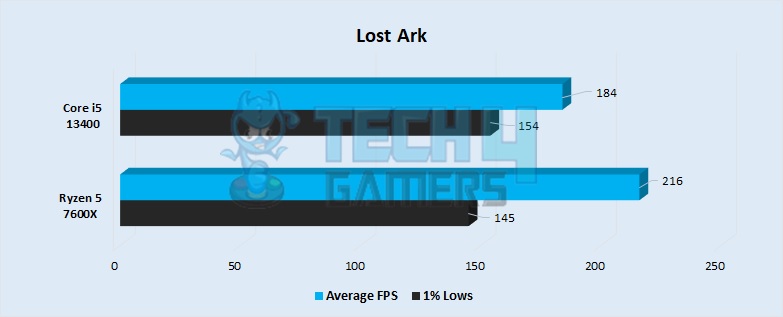
- Our test of Lost Ark performed well on the Ryzen 5, with an average framerate of around 216 FPS. In contrast, the i5 managed to get an average of around 184 FPS.
- The 1% lows were slightly lower on the Ryzen in this game, surprisingly, with minimums of around 145 FPS, while the i5 had lows of around 154 FPS.
PUBG
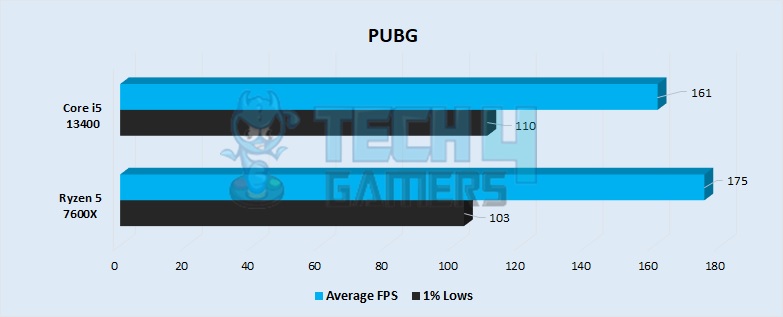
- The average framerates were higher on the Ryzen 5 7600X in our test of PUBG, around 175 FPS, while the i5 had a slightly less smooth performance of 161 FPS on average.
- However, in the case of 1% lows, the 13400 was ahead with 110 FPS. The 7600X provided 103 FPS.
Total War: Three Kingdoms
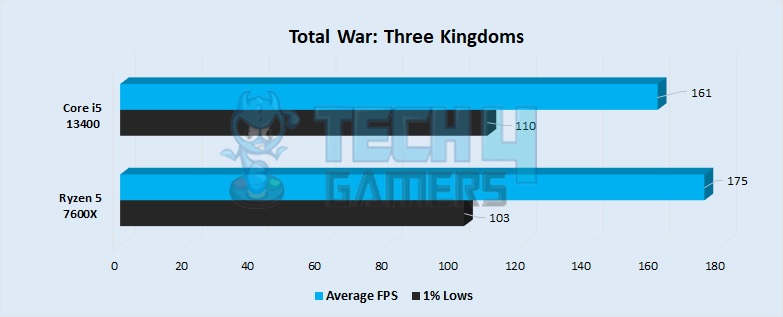
- The Core i5-13400 produced a higher average frame rate of 207 FPS, whereas the Ryzen 5 7600X delivered a 203 FPS average in Total War benchmarks.
- The Core i5-13400 also had a better Low 1% performance during this game. The low 1% frame rates of the R5 7600X and i5-13400 were 98 FPS and 117 FPS, respectively.
Ryzen 5 7600X vs Intel i5-13400 – Overall Gaming Analysis
| Processor | Average FPS | 1% Lows |
|---|---|---|
| Core i9 13900KS | 📈 247.5 | 📉 175.7 |
| Ryzen 9 7950X | 📈 235 | 📉 165.1 |
| Winner: Core i9 13900KS | ||
Going through our gaming benchmarks, we discovered that the Ryzen 5 7600X dominated the Intel Core i5 13400 at an overall lead of 31.2 FPS or 17.6% better gaming than the Core i5-13400. Also, the Ryzen 5 7600X provided an overall 10 FPS higher or 8.3% more effective performance than the Core i5-13400.
Power Consumption
| Games | AMD Ryzen 5 7600X (W) | Intel Core i5-13400 (W) |
|---|---|---|
| Average Power Consumption | 89 ⚡️ | 58⚡️ |
| Winner: Intel Core i5-13400 | ||
Looking at the power ratings of both the processors from our tests, we analyzed that the Ryzen 5 7600X devoured around 54% more power than the Intel Core i5-13400. This gap tilts the scales towards the Intel i5-13400 as it becomes the choice of budget-conscious gamers who want low-wattage setups.
Thermal Efficiency
| Games | AMD Ryzen 5 7600X (°C) | Intel Core i5 13400 (°C) |
|---|---|---|
| Average Thermal Capacity | 50🌡️ | 40🌡️ |
| Winner: Intel Core i5 13400 | ||
After thoroughly testing both CPUs, we concluded that in the above-discussed games at 1080p, the Core i5-13400 is 25.25% more thermally efficient, thanks to its PCG 2020C. The Intel i5-13400 is more feasible in thermal levels as compared to the AMD Ryzen 5 7600X as well.
Ryzen 5 7600X vs Intel i5-13400 – Price And Availability
| GPU | MSRP | Current Price |
|---|---|---|
| AMD Ryzen 5 7600X | 💲221 | 💲230 |
| Intel Core i5-13400 | 💲300 | 💲250 |
| Price Difference | 35.75% | 8.69% |
Considering the market prices for both processors nowadays, we see that the Intel core i5-13400 is getting sold at an 8.79% more costly price tag than the AMD Ryzen 5 7600X. Regarding availability, the Intel Core i5-13400 was flying off the shelves but is now readily available. The Ryzen 5 7600X is also easily available in markets.
Wrapping Up – Which One Do We Recommend?
AMD Ryzen 5 7600X: The Ryzen 5 7600X is a powerful processor, offering more performance per buck as compared to the Intel i5-13400. This can be proved by the fact that the Ryzen 5 7600X outperforms the Core i5-13400 by 17.6% during 1080p games.
Intel Core i5 13400: The Intel i5-13400 is also a fantastic budget-range option if you want to go down the Intel route and can only manage to spend $220. Moreover, this processor can efficiently save some watts and degrees under the skin, proving itself an economical option.
We recommend the users buy the AMD Ryzen 5 7600X because it is an excellent option available in a budget range, with higher framerates than the Intel Core i5 13400 but maintains slightly higher but excellent power and thermal ratings for a change.
Common Questions Answered
The Core i5-13400 cannot be overclocked. Nevertheless, the Ryzen 5 7600X is unlocked for overclocking.
The Core i5-13400 supports the DDR4 and DDR5 memories. However, the Ryzen 5 7600X only supports DDR5 memory, and DDR4 can not be used with it.
More from Ryzen 5 7600X:
More from Core i5 13400:
Thank you! Please share your positive feedback. 🔋
How could we improve this post? Please Help us. 😔
[Comparisons Expert]
Abdemanaf is a skilled creative writer who has been honing his craft since 2011. While initially working in different fields, he found a passion for technology and has been exploring the tech world since early 2015. Over the years, he has developed an in-depth knowledge of the latest tech trends and product offerings by various companies.
Abdemanaf’s writing reflects his analytical mindset and ability to think critically. He has a knack for breaking down complex technical information into easily digestible pieces, making his articles engaging and accessible to readers from all backgrounds. In February 2022, he joined Tech4Gamers as a blog and product comparison writer, where he has been able to hone his skills further.
As a writer, Abdemanaf is dedicated to staying up-to-date with the latest technological advancements and trends, enabling him to provide readers with the most relevant and accurate information. He is always eager to learn more and is constantly seeking new challenges to improve his skills.
Get In Touch: manaf@tech4gamers.com


